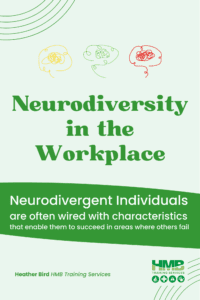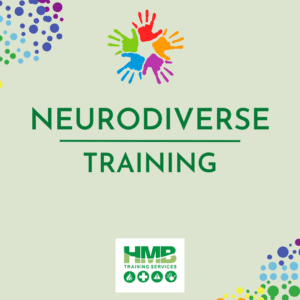In today’s fast-changing work world, neurodiversity is becoming more important. It’s changing how we manage talent and include everyone in the workplace. Our Neurodiversity in the Workplace: A Training Guide will fig deeper into neurodiversity, showing how to make a space where everyone can do their best.

Key Takeaways
- Learn about neurodiversity and how it affects work
- Find out about different neurodivergent conditions and their strengths
- See how neurodiversity is changing work environments
- Clear up myths about neurodivergent people and their abilities
- Discover the real benefits of welcoming neurodiversity in your team
This guide is a great tool for HR, managers, and colleagues. It helps create a welcoming, supportive work culture. By understanding neurodiversity, we can tap into the potential of our diverse team. This leads to a fairer and more creative future.
Understanding Neurodiversity: Core Concepts and Definitions
The neurodiversity movement sees differences in how we think as natural, not flaws. This change is key for understanding conditions like autism, ADHD, and dyslexia. It shows that these differences are part of the human experience.
Types of Neurodivergent Conditions
Neurodivergent conditions cover a wide range of differences in how we think and process information. Each condition has its own special traits and strengths. Here are a few examples:
- Autism spectrum disorder – It affects how we communicate, process sensory information, and behave.
- ADHD – It makes it hard to focus, stay still, and control impulses.
- Dyslexia – It impacts how we read, write, and understand language.
- Dyspraxia – It makes motor skills, like coordination and planning, challenging.
- Dyscalculia – It affects how we understand and work with numbers.
The Neurodiversity Paradigm Shift
The neurodiversity movement changes how we see neurodivergent conditions. Instead of seeing them as flaws, we celebrate them as natural differences. It highlights the unique strengths and contributions neurodivergent individuals can make.
Breaking Down Common Misconceptions
Neurodiversity training aims to clear up common myths about neurodivergent people. These myths might say they’re less capable or can’t succeed in jobs. They might also think support is too expensive or hard to provide.
By understanding neurodiversity better, we can make workplaces more welcoming. This lets neurodivergent employees reach their full potential.
Benefits of Neurodiversity in Professional Environments
Neurodiversity in the workplace brings a lot of benefits. It unlocks new potential and drives innovation. People with neurodiversity have unique strengths and talents that help organisations succeed.
One big advantage is the different ways neurodivergent people solve problems. They are great at thinking analytically, spotting patterns, and paying attention to details. These skills are very useful in today’s fast and complex business world. By using these differences, companies can become more creative and solve problems in new ways.
| Neurodiversity Advantage | Impact on the Workplace |
|---|---|
| Heightened Focus and Attention to Detail | Improved quality control, increased efficiency, and a reduced risk of errors |
| Exceptional Logical and Analytical Thinking | Enhanced problem-solving capabilities, data-driven decision making, and strategic foresight |
| Innovative and Unconventional Approaches | Breakthrough ideas, product innovations, and disruptive business strategies |
Also, a neurodivergent team makes the workplace more inclusive and dynamic. It’s a place where everyone’s ideas are valued and teamwork is encouraged. This makes employees happier and more engaged. It also makes the company a great place to work, attracting the best talent.
“Neurodiversity is the key to innovation. By embracing diverse ways of thinking, we unlock new avenues for growth and success.”
The benefits of neurodiversity go beyond what individuals can do. When companies support neurodivergent people, they open up a world of workplace innovation and diverse perspectives. This leads to even more neurodiversity advantages for the company.
Neurodiversity in the Workplace: A Training Guide: An Awareness into Neurodiversity
Creating effective neurodiversity training is key for inclusive workplaces. This guide covers strategies for inclusive training, awareness initiatives, and measuring their impact. It aims to improve employee satisfaction and organisational culture.
Creating Inclusive Training Materials
Training materials for neurodiversity awareness must be accessible and engaging. Use visual aids, audio recordings, and interactive exercises to reach different learners. The language should be clear and free from jargon, making the learning environment welcoming.
Developing Awareness Programmes
Good neurodiversity awareness programmes are ongoing, not just one-time events. They should be part of the organisation’s professional development. Include panel discussions, mentorship schemes, and workshops to deepen understanding and empathy.
Measuring Training Effectiveness
It’s important to evaluate the impact of neurodiversity training. Use surveys, focus groups, and performance metrics to measure changes. Regularly review and refine training to ensure a positive impact on workplace culture.
| Metric | Description | Desired Outcome |
|---|---|---|
| Employee Satisfaction | Measure of overall job satisfaction and engagement among neurodivergent employees | Increase in satisfaction and engagement levels |
| Inclusive Behaviours | Observation and assessment of inclusive behaviours, such as accommodations, collaboration, and communication | Increase in the frequency and quality of inclusive behaviours |
| Disclosure Rates | Percentage of neurodivergent employees who feel comfortable disclosing their condition | Increase in disclosure rates, indicating a more supportive and accepting workplace |
By focusing on neurodiversity awareness and inclusive training, organisations can create a supportive workplace. This empowers neurodivergent individuals, unlocking their potential and driving success.
Workplace Accommodations and Support Strategies
Creating an inclusive workplace for neurodivergent employees is crucial. It involves making reasonable adjustments, using assistive technology, and setting up sensory-friendly spaces. These steps can greatly improve their work experience and productivity.
Offering flexible work options, like remote work or adjusting hours, can help a lot. It lets neurodivergent individuals work in a way that suits them best. Giving them access to tools like noise-cancelling headphones or ergonomic furniture also helps them manage their environment better.
Designing workspaces that are calm and free from distractions is key. These spaces should have adjustable lighting and quiet areas. Such environments support the unique needs of neurodivergent team members. They help everyone feel included and valued.
By offering various accommodations and support, companies can create a place where neurodivergent employees can flourish. This not only helps them but also boosts the whole team’s performance and creativity.
- Flexible work arrangements (e.g., remote work, adjusted schedules)
- Assistive technologies (e.g., noise-cancelling headphones, ergonomic furniture)
- Sensory-friendly workspaces (e.g., adjustable lighting, minimised distractions)
“Embracing neurodiversity in the workplace is not only the right thing to do, but it also brings immense value to the organisation. By providing the right support and accommodations, we unlock the unique strengths and talents of our neurodivergent employees.”
Building an Inclusive Organisational Culture
Creating a culture that welcomes neurodiversity is key for any business’s success. This part talks about the main steps to achieve this. It focuses on the importance of leadership, good communication, and safe spaces for neurodivergent employees.
Leadership’s Role in Promoting Neurodiversity
Leadership is the heart of a neurodiversity-friendly workplace. Leaders who support neurodiversity and challenge wrong beliefs are crucial. They help create a culture that values differences and helps all employees do their best.
By showing inclusive behaviour and making neurodiversity a core value, leaders can lead positive change.
Communication Best Practices
Good communication is vital for an inclusive workplace. Using clear and simple language, offering different ways to share information, and making adjustments like written agendas help neurodivergent employees. It’s also important to listen well and show empathy to make everyone feel safe.
Creating Safe Spaces for Disclosure
It’s important to make a space where neurodivergent employees can share their needs and experiences. Training on neurodiversity, encouraging open talks, and keeping things confidential and fair helps build trust. This trust lets neurodivergent people get the help they need to succeed at work.
| Inclusive Leadership | Neurodiversity-Friendly Communication | Psychological Safety |
|---|---|---|
|
|
|
By focusing on inclusive leadership, good communication, and safe spaces, companies can create a culture that values neurodiversity. This unlocks the potential of neurodivergent individuals, leading to innovation and success.
Conclusion
As we finish, it’s clear that welcoming neurodiversity at work is essential. It’s not just the right thing to do; it’s also smart. By creating an inclusive space, we celebrate the strengths and views of neurodivergent workers. This leads to innovation, better productivity, and a more vibrant, strong team.
The path to workplace inclusion needs ongoing learning and a readiness to change old ways. But the benefits are huge. When we make our workplaces accessible and empower neurodivergent people, we unlock new potential. We also lead the way in the future of work.
Let’s keep learning, talking openly, and building a culture that values everyone’s unique gifts. By embracing neurodiversity, we’ll build a future where talent and potential grow. Here, innovation will flourish, and everyone will have the chance to shine and reach their highest potential.
FAQ
What is neurodiversity?
Neurodiversity is about the natural differences in how our brains work. It includes conditions like autism, ADHD, and dyslexia. These are seen as part of the natural variety of humans.
Why is neurodiversity important in the workplace?
Neurodiversity brings many benefits to work. It leads to more innovation and problem-solving. Neurodivergent people often have great skills in detail, pattern recognition, and thinking outside the box.
How can organisations create an inclusive environment for neurodivergent employees?
To be inclusive, offer flexible work and assistive tech. Make workspaces friendly for all senses. Also, teach about neurodiversity and value diverse views and safety.
What are the common misconceptions about neurodivergent individuals in the workplace?
Some think neurodivergent people are less capable or can’t work in teams. But, with the right support, they can excel. Their unique strengths and needs are valuable.
How can leaders and managers effectively support neurodivergent employees?
Leaders should promote neurodiversity and encourage open talk. Create safe spaces for needs to be shared. Train managers on how to support and include everyone.
Our Neurodiversity Training – Neurodiversity in the Workplace: A Training Guide
Neurodiversity Training for the Workplace for managers, HR personnel and colleagues. The session aims to increase awareness of neurodiversity in the workplace and allow attendees the opportunity to discuss workplace specific circumstances, develop strategies to support a neurodivergent workforce and identify the next steps for their organisation.

The course includes:
- Overview of Neurodiversity
- Why neurodiversity is important
- Associated neurodevelopmental conditions
- Neurodiversity, mental health and wellbeing
- Overview of Autism Spectrum Conditions
- Communication differences
- Strategies to ensure effective communication
- Cognitive Differences in autism
- Strengths and challenges
- Sensory Differences
- Breakdown of senses
- Hyper/Hypo sensitivity
- Environmental considerations
- Neurodiversity best practice in the workplace
- Examples of reasonable adjustments:
- Recruitment processes
- In the workplace
- Examples of reasonable adjustments:
Our Neurodiversity Training is fully interactive with lots of practical games and tasks to perform, including a lot of opportunities for discussions to embed learning and to show ways to help an autistic colleague
More information click here; https://www.hmbtrainingservices.co.uk/latest-news/offer/neurodiversity-training-for-the-workplace
Or you can call us on 01543 4533338



